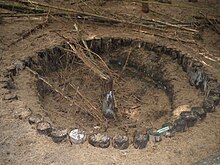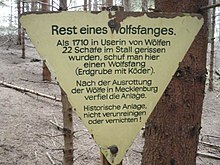Wolf catching
Systems for catching wolves are referred to as wolf catching .
Wolf catches were steep, mostly reinforced with wooden stakes or walled round pits. They were about 3 to 5 meters deep and 1.5 to 3.5 meters in diameter. In the middle of the pit there was a pole with a round wooden pedestal or wheel attached to it. A lamb, goat or poultry was tied to this pedestal as bait . The rest of the pit was either covered or camouflaged with brushwood and branches or with hinged lids. In shallower pits, sharpened stakes or catch irons were also set up. If the wolf tried to jump to the bait, it fell into the prepared trapping pit.
Wolf catches were used in Germany until the 18th century.
See also
- Wolfsgarten (Erzgebirge) , a fenced area for wolf hunting.
- Wolf pit
- Wolfsangel
Individual evidence
- ↑ a b Information from the National Park Office of the Müritz National Park at Zwenzower Wolfsfang
- ↑ Main State Archives Dresden, Copial in Berg- und Hütten-Matters 1658/1659, Bl. 63
Web links
- Walled wolf trap in the Aulenbach forest with pictures
- Wolfsfang Muerlenbach ( Memento from January 19, 2016 in the Internet Archive )
- Wolf catching Zwenzow at the Friends of Wild Wolves eV (with further pictures)

